
History of slavery in Maryland
Encyclopedia
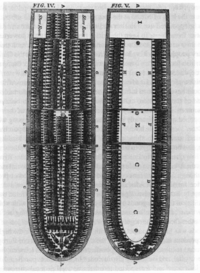
Virginia
The Commonwealth of Virginia , is a U.S. state on the Atlantic Coast of the Southern United States. Virginia is nicknamed the "Old Dominion" and sometimes the "Mother of Presidents" after the eight U.S. presidents born there...
. The early settlements and population centers of the Province tended to cluster around the rivers and other waterways that empty into the Chesapeake Bay
Chesapeake Bay
The Chesapeake Bay is the largest estuary in the United States. It lies off the Atlantic Ocean, surrounded by Maryland and Virginia. The Chesapeake Bay's drainage basin covers in the District of Columbia and parts of six states: New York, Pennsylvania, Delaware, Maryland, Virginia, and West...
; as in Virginia, Maryland's economy quickly became centered around the farming of tobacco
Tobacco
Tobacco is an agricultural product processed from the leaves of plants in the genus Nicotiana. It can be consumed, used as a pesticide and, in the form of nicotine tartrate, used in some medicines...
for sale in Europe. The need for cheap labor to help with the growth of tobacco, and later with the mixed farming economy that developed when tobacco prices collapsed, led to a rapid expansion of indentured servitude and, later, forcible immigration and enslavement of Africans.
Maryland developed into a plantation
Plantation
A plantation is a long artificially established forest, farm or estate, where crops are grown for sale, often in distant markets rather than for local on-site consumption...
colony by the 18th century. In 1700 there were about 25,000 people and by 1750 that had grown more than 5 times to 130,000. By 1755, about 40% of Maryland's population was black. Maryland planters also made extensive use of indentured servants and penal labor. An extensive system of rivers facilitated the movement of produce from inland plantations to the Atlantic coast for export. Baltimore
Baltimore
Baltimore is the largest independent city in the United States and the largest city and cultural center of the US state of Maryland. The city is located in central Maryland along the tidal portion of the Patapsco River, an arm of the Chesapeake Bay. Baltimore is sometimes referred to as Baltimore...
was the second-most important port in the eighteenth-century South, after Charleston, South Carolina
Charleston, South Carolina
Charleston is the second largest city in the U.S. state of South Carolina. It was made the county seat of Charleston County in 1901 when Charleston County was founded. The city's original name was Charles Towne in 1670, and it moved to its present location from a location on the west bank of the...
.
Maryland remained loyal to the Union during the American Civil War
American Civil War
The American Civil War was a civil war fought in the United States of America. In response to the election of Abraham Lincoln as President of the United States, 11 southern slave states declared their secession from the United States and formed the Confederate States of America ; the other 25...
, and so the state was not included under the 1862 Emancipation Proclamation
Emancipation Proclamation
The Emancipation Proclamation is an executive order issued by United States President Abraham Lincoln on January 1, 1863, during the American Civil War using his war powers. It proclaimed the freedom of 3.1 million of the nation's 4 million slaves, and immediately freed 50,000 of them, with nearly...
, which declared all slaves in Southern Confederate states (but not those in Union border states) to be free. As a consequence of this anomaly, a constitutional convention was held in Maryland in 1864, which culminated in the passage of a new state constitution
Maryland Constitution of 1864
The Maryland Constitution of 1864 was the third of the four constitutions which have governed the U.S. state of Maryland. A controversial product of the Civil War and in effect only until 1867, when the state's present constitution was adopted, the 1864 document was short-lived.-Drafting:The 1864...
on November 1 of that year. Article 24 of that document outlawed the practice of slavery, and the right to vote was extended to non-white males in the Maryland Constitution of 1867, which remains in effect today.
Beginnings
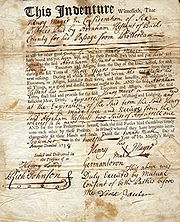
Africa
Africa is the world's second largest and second most populous continent, after Asia. At about 30.2 million km² including adjacent islands, it covers 6% of the Earth's total surface area and 20.4% of the total land area...
ns to be brought to English North America
North America
North America is a continent wholly within the Northern Hemisphere and almost wholly within the Western Hemisphere. It is also considered a northern subcontinent of the Americas...
landed in Virginia
Virginia
The Commonwealth of Virginia , is a U.S. state on the Atlantic Coast of the Southern United States. Virginia is nicknamed the "Old Dominion" and sometimes the "Mother of Presidents" after the eight U.S. presidents born there...
in 1619. These individuals appear to have been treated as indentured servant
Indentured servant
Indentured servitude refers to the historical practice of contracting to work for a fixed period of time, typically three to seven years, in exchange for transportation, food, clothing, lodging and other necessities during the term of indenture. Usually the father made the arrangements and signed...
s, and a significant number of African slaves even won their freedom through fulfilling a work contract or for converting to Christianity. Some successful free people of color, such as Anthony Johnson
Anthony Johnson (American Colonial)
Anthony Johnson was an Angolan African held as an indentured servant by a merchant in the Colony of Virginia in 1620, but later freed to become a successful tobacco farmer and owner...
, acquired slaves or indentured servants themselves. This evidence suggests that racial attitudes were much more flexible in the colonies in the 17th century than they would subsequently become.
The first Africans were brought to Maryland in 1642, when 13 slaves arrived at St. Mary's City, the first English settlement in the Province. However, their legal status was initially unclear and colonial courts tended to rule that a slave who accepted Christian baptism should be freed. In order to protect the rights of their owners, laws began to be passed to clarify the legal position. In 1664, under the governorship of Charles Calvert, 3rd Baron Baltimore
Charles Calvert, 3rd Baron Baltimore
Charles Calvert, 3rd Baron Baltimore, 2nd Proprietor and 6th and 9th Proprietary Governor of Maryland , inherited the colony in 1675 upon the death of his father, Cecilius Calvert, 2nd Baron Baltimore. He had been his father's Deputy Governor since 1661 when he arrived in the colony at the age of 24...
, the Assembly ruled that slaves should be slaves for life, and that the children of slaves should also be enslaved for life. The 1664 Act read as follows:
- Be it enacted by the Right Honorable, the Lord Proprietory, by the advice and consent of the Upper and Lower House of this present General Assembly, that all negroes or other slaves already within the Province, and all negroes and other slaves to be hereafter imported into the Province shall serve durante vita. And all children born of any negro or other slave shall be slaves as their fathers were for the term of their lives."
In this way the institution of slavery in Maryland would become indefinitely self-perpetuating, and the numbers of slaves in Maryland would grow inexorably until the institution's final eradication, 200 years later, during the American Civil War
American Civil War
The American Civil War was a civil war fought in the United States of America. In response to the election of Abraham Lincoln as President of the United States, 11 southern slave states declared their secession from the United States and formed the Confederate States of America ; the other 25...
.
The wording of the 1663 Act suggests that Africans may not have been the only slaves in Maryland. Although there is no direct evidence of the enslavement of Native American
Indigenous peoples of the Americas
The indigenous peoples of the Americas are the pre-Columbian inhabitants of North and South America, their descendants and other ethnic groups who are identified with those peoples. Indigenous peoples are known in Canada as Aboriginal peoples, and in the United States as Native Americans...
s, the reference to "negroes and other slaves" may imply that, as in Massachusetts, local Indians may have been enslaved by the colonists. Alternatively, the wording in the Act may have been intended to apply to slaves of African origin but of mixed-race ancestry
Mulatto
Mulatto denotes a person with one white parent and one black parent, or more broadly, a person of mixed black and white ancestry. Contemporary usage of the term varies greatly, and the broader sense of the term makes its application rather subjective, as not all people of mixed white and black...
.
Further legislation would follow, entrenching and deepening the institution of slavery. In 1671 the Assembly passed an Act stating expressly that baptism of a slave would not lead to freedom. The Act was apparently intended to save the souls of the enslaved; such that no slave owner should be discouraged from baptizing his human property for fear of losing it. In practice, such laws permitted both Christianity and slavery to develop hand in hand.
However, at this early stage in Maryland history slaves were not especially numerous in the Province, being greatly outnumbered by indentured servants from England. the full impact of such harsh slave laws would not be felt until large scale importation of Africans began in earnest in the 1690s. During the second half of the 17th century, the British economy gradually improved and the supply of British indentured servants declined, as poor Britons had better economic opportunities at home. At the same time, Bacon's Rebellion
Bacon's Rebellion
Bacon's Rebellion was an uprising in 1676 in the Virginia Colony in North America, led by a 29-year-old planter, Nathaniel Bacon.About a thousand Virginians rose because they resented Virginia Governor William Berkeley's friendly policies towards the Native Americans...
of 1676 led planters to worry about the prospective dangers of creating a large class of restless, landless, and relatively poor white men (most of them former indentured servants). Wealthy Virginia and Maryland planters began to buy slaves in preference to indentured servants during the 1660s and 1670s, and poorer planters followed suit by c.1700. Slaves cost more than servants, so initially only the wealthy could invest in slaves. By the end of the century there had been a shift away from indentured servants, and in favor of the importation of African slaves.
Eighteenth Century

Plantation
A plantation is a long artificially established forest, farm or estate, where crops are grown for sale, often in distant markets rather than for local on-site consumption...
colony. In 1700 there were about 25,000 people in Maryland and by 1750 that had grown more than 5 times to 130,000. By 1755, about 40% of Maryland's population was black. In 1753 the Maryland assembly took further harsh steps to entrench the institution of slavery, passing a law which prohibited any slave owner from voluntarily manumitting his slaves. This meant that even slave owners who wished to free their own slaves were henceforth prevented by law from doing so.
At this stage there were few voices of dissent in Maryland. Although only the wealthy could afford slaves, even poor whites who did not own slaves may have aspired to own them someday. And the identity of many whites in Maryland, and the South in general, was by now tied up in the idea of white supremacy. As the French political philosopher Montesquieu noted in 1748: "It is impossible for us to suppose these creatures [enslaved Africans] to be men; because allowing them to be men, a suspicion would follow that we ourselves are not Christians."
Revolutionary War
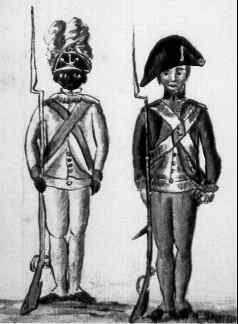
American Revolution
The American Revolution was the political upheaval during the last half of the 18th century in which thirteen colonies in North America joined together to break free from the British Empire, combining to become the United States of America...
was liberty, but only on behalf of white men, and certainly not slaves. The British, desperately short of manpower, sought to enlist African American soldiers to fight on behalf of the Crown, promising them liberty in exchange. As a result of the looming crisis in 1775 the Royal Governor of Virginia, Lord Dunmore
John Murray, 4th Earl of Dunmore
John Murray, 4th Earl of Dunmore was a British peer and colonial governor. He was the son of William Murray, 3rd Earl of Dunmore, and his wife Catherine . He is best remembered as the last royal governor of the Colony of Virginia.John was the eldest son of William and Catherine Murray, and nephew...
, issued a proclamation that promised freedom to servants and slaves who were able to bear arms and join his Loyalist Ethiopian Regiment
Ethiopian Regiment
Lord Dunmore's Ethiopian Regiment or Ethiopian Regiment was the name given to a British colonial military unit organized during the American Revolution by John Murray, 4th Earl of Dunmore, and last Royal Governor of Virginia. Composed of slaves who had escaped from Patriot masters, it was led by...
:
...I do require every Person capable of bearing Arms, to resort to His MAJESTY'S STANDARD, or be looked upon as Traitors to His MAJESTY'S Crown and Government, and thereby become liable to the Penalty the Law inflicts upon such Offenses; such as forfeiture of Life, confiscation of Lands, &. &. And I do hereby further declare all indented Servants, Negroes, or others, (appertaining to Rebels,) free that are able and willing to bear Arms, they joining His MAJESTY'S Troops as soon as may be, for the more speedily reducing this Colony to a proper Sense of their Duty, to His MAJESTY'S Crown and Dignity.--- Lord Dunmore's Proclamation, November 7, 1775
About 800 men joined up; some helped rout the Virginia militia at the Battle of Kemp's Landing
Battle of Kemp's Landing
The Battle of Kemp's Landing, also known as the Skirmish of Kempsville, was a skirmish in the American Revolutionary War that occurred on November 15, 1775...
and fought in the Battle of Great Bridge
Battle of Great Bridge
The Battle of Great Bridge was fought December 9, 1775, in the area of Great Bridge, Virginia, early in the American Revolutionary War. The victory by Continental Army and militia forces led to the departure of Governor Lord Dunmore and any remaining vestiges of British power from the Colony of...
on the Elizabeth River
Elizabeth River (Virginia)
The Elizabeth River is a tidal estuary forming an arm of Hampton Roads harbor at the southern end of Chesapeake Bay in southeast Virginia in the United States. It is located along the southern side of the mouth of the James River, between the cities of Portsmouth and Norfolk...
, wearing the motto "Liberty to Slaves", but this time they were defeated. The remains of their regiment were then involved in the evacuation of Norfolk
Norfolk, Virginia
Norfolk is an independent city in the Commonwealth of Virginia in the United States. With a population of 242,803 as of the 2010 Census, it is Virginia's second-largest city behind neighboring Virginia Beach....
, after which they served in the Chesapeake
Chesapeake, Virginia
As of the census of 2000, there were 199,184 people, 69,900 households, and 54,172 families residing in the city. The population density was 584.6 people per square mile . There were 72,672 housing units at an average density of 213.3 per square mile...
area. Unfortunately the camp that they had set up there suffered an outbreak of smallpox
Smallpox
Smallpox was an infectious disease unique to humans, caused by either of two virus variants, Variola major and Variola minor. The disease is also known by the Latin names Variola or Variola vera, which is a derivative of the Latin varius, meaning "spotted", or varus, meaning "pimple"...
and other diseases. This took a heavy toll, putting many of them out of action for some time. The survivors joined other British units and continued to serve throughout the war. Blacks were often the first to come forward to volunteer and a total of 12,000 blacks served with the British from 1775 to 1783. This factor had the effect of forcing the rebels to also offer freedom to those who would serve in the Continental army. Such promises were often reneged upon by both sides.
In general though, the war left the institution of slavery largely unaffected, and the prosperous life of Maryland planters continued. The writer Abbe Robin, who travelled through Maryland during the American Revolutionary War
American Revolutionary War
The American Revolutionary War , the American War of Independence, or simply the Revolutionary War, began as a war between the Kingdom of Great Britain and thirteen British colonies in North America, and ended in a global war between several European great powers.The war was the result of the...
, described the lifestyle enjoyed by families of wealth and status in the Province:
- "[Maryland houses] are large and spacious habitations, widely separated, composed of a number of buildings and surrounded by plantations extending farther than the eye can reach, cultivated...by unhappy black men whom European avarice brings hither...Their furniture is of the most costly wood, and rarest marbles, enriched by skilful and artistic work. Their elegant and light carriages are drawn by finely bred horses, and driven by richly apparelled slaves."
Methodists and Quakers
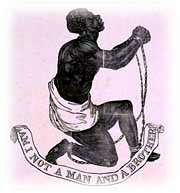
Christian
A Christian is a person who adheres to Christianity, an Abrahamic, monotheistic religion based on the life and teachings of Jesus of Nazareth as recorded in the Canonical gospels and the letters of the New Testament...
grounds. In 1780 the National Methodist Conference in Baltimore
Baltimore
Baltimore is the largest independent city in the United States and the largest city and cultural center of the US state of Maryland. The city is located in central Maryland along the tidal portion of the Patapsco River, an arm of the Chesapeake Bay. Baltimore is sometimes referred to as Baltimore...
officially condemned slavery, and in 1784 the church went further, threatening Methodist preachers with suspension if they owned slaves.
The Methodist movement in the United States as a whole was not of one voice on the subject of slavery; indeed many Southern congregations supported the institution, often citing Old Testament scriptures which appeared to represent slavery as a part of the natural order of things. New Testament writings were sometimes used to support the case for slavery as well. Some of the writings of Paul, especially in Ephesians, instruct slaves to remain obedient to their masters. Southern ideology also argued that slavery was beneficial for slaves, as well as their owners, arguing that slaves were offered protections from many ills.
In the mid 1790s the Methodists and the Quakers drew together to form the Maryland Society of the Abolition of Slavery. Together they lobbied the legislature, and in 1796 successfully achieved the repeal of the 1753 law which had prohibited a slave owner from voluntarily manumitting his slaves. In 1815 the two groups again co-operated to form the Protection Society of Maryland, a group which sought protection for free blacks living in the state.
Other churches in Maryland were more equivocal. The Roman Catholic Church
Roman Catholic Church
The Catholic Church, also known as the Roman Catholic Church, is the world's largest Christian church, with over a billion members. Led by the Pope, it defines its mission as spreading the gospel of Jesus Christ, administering the sacraments and exercising charity...
in Maryland had long tolerated slavery. Despite a firm stand for the spiritual equality of black people, and the resounding condemnation of slavery by Pope Gregory XVI
Pope Gregory XVI
Pope Gregory XVI , born Bartolomeo Alberto Cappellari, named Mauro as a member of the religious order of the Camaldolese, was Pope of the Catholic Church from 1831 to 1846...
in his bull
Papal bull
A Papal bull is a particular type of letters patent or charter issued by a Pope of the Catholic Church. It is named after the bulla that was appended to the end in order to authenticate it....
In Supremo Apostolatus
In Supremo Apostolatus
In Supremo Apostolatus is a papal bull issued by Pope Gregory XVI regarding the institution of slavery. Issued on December 3, 1839 as a result of a broad consultation among the College of Cardinals, the bull resoundingly denounces both the slave trade and the continuance of the institution of...
issued in 1839, the Catholic Church in Maryland continued in deeds, if not in public discourse, to support slaveholding interests.
Maryland State Colonization Society

Maryland State Colonization Society
The Maryland State Colonization Society was the Maryland branch of the American Colonization Society, an organization founded in 1816 with the purpose of returning free African Americans to what many Southerners considered greater freedom in Africa. The ACS helped to found the colony of Liberia in...
, founded in 1817, an auxiliary branch of the American Colonization Society
American Colonization Society
The American Colonization Society , founded in 1816, was the primary vehicle to support the "return" of free African Americans to what was considered greater freedom in Africa. It helped to found the colony of Liberia in 1821–22 as a place for freedmen...
which had been founded in Washington D.C. in 1816. The MSCS had strong Christian support and was the primary vehicle for proposals to return free African Americans to what many Marylanders considered greater freedom in Africa
Africa
Africa is the world's second largest and second most populous continent, after Asia. At about 30.2 million km² including adjacent islands, it covers 6% of the Earth's total surface area and 20.4% of the total land area...
. It helped to found the colony
Colony
In politics and history, a colony is a territory under the immediate political control of a state. For colonies in antiquity, city-states would often found their own colonies. Some colonies were historically countries, while others were territories without definite statehood from their inception....
of Liberia
Liberia
Liberia , officially the Republic of Liberia, is a country in West Africa. It is bordered by Sierra Leone on the west, Guinea on the north and Côte d'Ivoire on the east. Liberia's coastline is composed of mostly mangrove forests while the more sparsely populated inland consists of forests that open...
in 1821–22, as a place for freedmen. The Maryland State Colonization Society was responsible for founding the Republic of Maryland
Republic of Maryland
The Republic of Maryland was a small African American nation which existed from 1854 to 1857, when it was united into what is now Liberia....
in West Africa, a short lived independent state that in 1857 was annexed by Liberia
Liberia
Liberia , officially the Republic of Liberia, is a country in West Africa. It is bordered by Sierra Leone on the west, Guinea on the north and Côte d'Ivoire on the east. Liberia's coastline is composed of mostly mangrove forests while the more sparsely populated inland consists of forests that open...
.
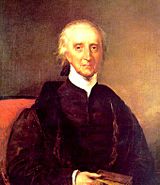
Charles Carroll of Carrollton
Charles Carroll of Carrollton was a wealthy Maryland planter and an early advocate of independence from Great Britain. He served as a delegate to the Continental Congress and later as United States Senator for Maryland...
, who was himself a Marylander and a substantial slaveholder. Although he supported the gradual abolition of slavery, he did not free his own slaves, perhaps fearing that they might be rendered destitute in the process. Carroll introduced a bill for the gradual abolition of slavery in the Maryland senate but it did not pass.
Many wealthy Maryland Planters were members of the MSCS. Among these were the Steuart family
Steuart family
The Steuart family of Maryland was a prominent political family in the early History of Maryland. Of Scottish descent, the Steuarts have their origins in Perthshire, Scotland...
, who owned considerable estates in the Chesapeake Bay, including Major General George H. Steuart, who was on the board of Managers, along with his father James Steuart, who was vice-president, and his brother, the physician Richard Sprigg Steuart
Richard Sprigg Steuart
Dr. Richard Sprigg Steuart was a Maryland physician and an early pioneer of the treatment of mental illness. He was instrumental in the expansion and modernisation of The Maryland Hospital for the Insane, now known as the Spring Grove Hospital Center, which became his life's work...
, also on the board of managers.
In an open letter to John Carey in 1845, published in Baltimore
Baltimore
Baltimore is the largest independent city in the United States and the largest city and cultural center of the US state of Maryland. The city is located in central Maryland along the tidal portion of the Patapsco River, an arm of the Chesapeake Bay. Baltimore is sometimes referred to as Baltimore...
by the printer John Murphy, Richard Sprigg Steuart set out his views on the subject of slavery in Maryland. Such opinions must have been widespread among Maryland slaveholders:
- "The colored man [must] look to Africa, as his only hope of preservation and of happiness...it can not be denied that the question is fraught with great difficulties and perplexities, but...it will be found that this course of procedure...will...at no very distant period, secure the removal of the great body of the African people from our State. The President of the Maryland Colonization Society points to this in his address, where he says "the object of Colonization is to prepare a home in Africa for the free colored people of the State, to which they may remove when the advantages which it offers, and above all the pressure of irresistible circumstances in this country, shall excite them to emigrate."
The society proposed from the outset "to be a remedy for slavery", and declared in 1833:
- "Resolved, That this society believe, and act upon the belief, that colonization tends to promote emancipation, by affording the emancipated slave a home where he can be happier than in this country, and so inducing masters to manumitManumissionManumission is the act of a slave owner freeing his or her slaves. In the United States before the passage of the Thirteenth Amendment to the United States Constitution, which abolished most slavery, this often happened upon the death of the owner, under conditions in his will.-Motivations:The...
who would not do so unconditionally...[so that] at a time not remote, slavery would cease in the state by the full consent of those interested."
Republic of Maryland founded in Africa
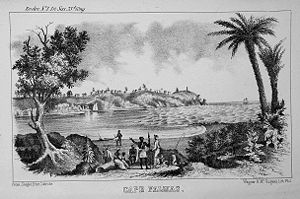
In December 1831, the Maryland state legislature appropriated US$10,000 for 26 years to transport free blacks and ex-slaves from the United States to Africa. The act appropriated funds of up to $20,000 a year, up to a total of $200,000, in order to commence the process of African colonization. Most of the money would be spent on the colony itself, to make it attractive to settlers. Free passage was offered, plus rent, 5 acres (20,234.3 m²) of land to farm, and low interest loans which would eventually be forgiven if the settlers chose to remain in Liberia. The remainder was spent on agents paid to publicize the new colony.
At the same time, measures were enacted to force freed slaves to leave the state, unless a court of law found them to be of such "extraordinary good conduct and character" that they might be permitted to remain. Any slave manumitted by his master must be reported to the authorities, and county clerks who did not do so could be fined. It was in order to carry out this legislative purpose that the Maryland State Colonization Society was established.
In 1832 the legislature placed new restrictions on the liberty of free blacks, in order to encourage emigration. They were not permitted to vote, serve on juries, or hold public office. Unemployed ex-slaves without visible means of support could be re-enslaved at the discretion of local sheriffs. By this means the supporters of colonization hoped to encourage free blacks to leave the state.
John Latrobe, for two decades the president of the MSCS, and later president of the ACS, proclaimed that settlers would be motivated by the "desire to better one's condition", and that sooner or later "every free person of color" would be persuaded to leave Maryland.
Underground Railroad
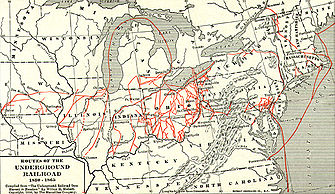
Underground Railroad
The Underground Railroad was an informal network of secret routes and safe houses used by 19th-century black slaves in the United States to escape to free states and Canada with the aid of abolitionists and allies who were sympathetic to their cause. The term is also applied to the abolitionists,...
was established to guide slaves to safety in Northern states. The many Indian trails and waterways of Maryland, and in particular the countless inlets of the Chesapeake Bay
Chesapeake Bay
The Chesapeake Bay is the largest estuary in the United States. It lies off the Atlantic Ocean, surrounded by Maryland and Virginia. The Chesapeake Bay's drainage basin covers in the District of Columbia and parts of six states: New York, Pennsylvania, Delaware, Maryland, Virginia, and West...
, afforded numerous ways to escape north to Pennsylvania
Pennsylvania
The Commonwealth of Pennsylvania is a U.S. state that is located in the Northeastern and Mid-Atlantic regions of the United States. The state borders Delaware and Maryland to the south, West Virginia to the southwest, Ohio to the west, New York and Ontario, Canada, to the north, and New Jersey to...
. As the numbers of escaping slaves grew, so did the reward for their capture. In 1806 the reward offered for recaptured slaves was $6, but by 1833 it had risen to $30. In 1844 recaptured slaves fetched $15 if recaptured within 30 miles (48.3 km) of the owner, $50 if captured more than 30 miles (48.3 km) away.
By the 1850s few Marylanders still believed that Colonization was the solution to the problem of slavery. By this time around one in every six Maryland families had slaves, but support for the institution of slavery was localized; varying according to its importance to the local economy. Marylanders might agree in principle that slavery could and should be abolished, but turning theory into practice would prove elusive. Slavery was too deeply embedded into Maryland society for it to be voluntarily eradicated, and the end would come only with war and bloodshed.
| Census Year | 1790 | 1800 | 1810 | 1820 | 1830 | 1840 | 1850 | 1860 |
|---|---|---|---|---|---|---|---|---|
| All States | 694,207 | 887,612 | 1,130,781 | 1,529,012 | 1,987,428 | 2,482,798 | 3,200,600 | 3,950,546 |
| Maryland | 103,036 | 105,635 | 111,502 | 107,398 | 102,994 | 89,737 | 90,368 | 87,189 |
Approach of war
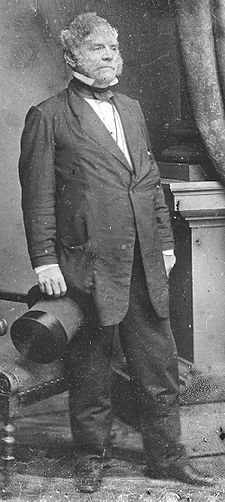
Kentucky
The Commonwealth of Kentucky is a state located in the East Central United States of America. As classified by the United States Census Bureau, Kentucky is a Southern state, more specifically in the East South Central region. Kentucky is one of four U.S. states constituted as a commonwealth...
and Missouri
Missouri
Missouri is a US state located in the Midwestern United States, bordered by Iowa, Illinois, Kentucky, Tennessee, Arkansas, Oklahoma, Kansas and Nebraska. With a 2010 population of 5,988,927, Missouri is the 18th most populous state in the nation and the fifth most populous in the Midwest. It...
, Maryland found herself in a difficult position as war approached, with opinion heavily divided between supporters of North and South. The western and northern parts of the state, especially those Marylanders of German origin, tended to favour remaining in the Union, whilst the low-lying Chesapeake Bay area, with its slave economy, tended to support the Confederacy
Confederate States of America
The Confederate States of America was a government set up from 1861 to 1865 by 11 Southern slave states of the United States of America that had declared their secession from the U.S...
if not outright secession.
However, Maryland would remain part of the Union during the United States Civil War, thanks to President Abraham Lincoln
Abraham Lincoln
Abraham Lincoln was the 16th President of the United States, serving from March 1861 until his assassination in April 1865. He successfully led his country through a great constitutional, military and moral crisis – the American Civil War – preserving the Union, while ending slavery, and...
's swift action to suppress dissent in Maryland. The belated assistance of Governor Hicks also played an important role, as Hicks, initially indecisive, eventually co-operated with federal officials to stop further violence and prevent a move to secession.
As in Virginia and Delaware, many planters in Maryland had freed their slaves in the years following the Revolutionary War, and by 1860 Maryland's free black population comprised 49.1% of the total number of African Americans in the state. After John Brown
John Brown (abolitionist)
John Brown was an American revolutionary abolitionist, who in the 1850s advocated and practiced armed insurrection as a means to abolish slavery in the United States. He led the Pottawatomie Massacre during which five men were killed, in 1856 in Bleeding Kansas, and made his name in the...
's raid on Harper's Ferry, Virginia
John Brown's raid on Harpers Ferry
John Brown's raid on Harpers Ferry was an attempt by white abolitionist John Brown to start an armed slave revolt by seizing a United States Arsenal at Harpers Ferry in Virginia in 1859...
(now in West Virginia
West Virginia
West Virginia is a state in the Appalachian and Southeastern regions of the United States, bordered by Virginia to the southeast, Kentucky to the southwest, Ohio to the northwest, Pennsylvania to the northeast and Maryland to the east...
), some citizens in slaveholding areas began forming local militias. Of the 1860 population of 687,000, about 60,000 men joined the Union and about 25,000 fought for the Confederacy. The political sentiments of each group generally reflected their economic interests.
The first bloodshed of the Civil War occurred on April 19, 1861 in Baltimore
Baltimore riot of 1861
The Baltimore riot of 1861 was an incident that took place on April 19, 1861, in Baltimore, Maryland between Confederate sympathizers and members of the Massachusetts militia en route to Washington for Federal service...
involving Massachusetts troops who were fired on by civilians while marching between railroad stations. After that, Baltimore Mayor George William Brown
George William Brown
George William Brown was the mayor of Baltimore, Maryland from 1860 to 1861.-Pratt Street Riot:Brown played an important role in controlling the Pratt Street Riot on April 19, 1861, at the onset of the American Civil War. After the Pratt Street Riot, some small skirmishes occurred throughout...
, Marshal George P. Kane, and former Governor Enoch Louis Lowe
Enoch Louis Lowe
Enoch Louis Lowe served as the 29th Governor of the state of Maryland in the United States from 1851 to 1854.-Early life:...
requested that Maryland Governor Thomas H. Hicks, a slave owner from the Eastern Shore, burn the railroad bridges and cut the telegraph lines leading to Baltimore to prevent further troops from entering the state. Hicks reportedly approved this proposal. These actions were addressed in the famous federal court case of Ex parte Merryman
Ex parte Merryman
Ex parte Merryman, 17 F. Cas. 144 , is a well-known U.S. federal court case which arose out of the American Civil War. It was a test of the authority of the President to suspend "the privilege of the writ of habeas corpus"...
.
Towards emancipation

On April 10, 1862, Congress declared that the Federal government would compensate slave owners who freed their slaves. Slaves in the District of Columbia were freed on April 16, 1862 and their owners were duly compensated. In July 1862 Congress took a major step towards emancipation by passing the Second Confiscation Act, which permitted the Union army to enlist African-American soldiers, and barred the army from recapturing runaway slaves. In the same month Lincoln offered to buy out Maryland slaveholders, offering $300 for each emancipated slave, but Crisfield (unwisely as it turned out) rejected this offer.
On September 17, 1862 General Robert E. Lee
Robert E. Lee
Robert Edward Lee was a career military officer who is best known for having commanded the Confederate Army of Northern Virginia in the American Civil War....
's invasion of Maryland was turned back by the Union army at the tactically inconclusive but strategically important Battle of Antietam
Battle of Antietam
The Battle of Antietam , fought on September 17, 1862, near Sharpsburg, Maryland, and Antietam Creek, as part of the Maryland Campaign, was the first major battle in the American Civil War to take place on Northern soil. It was the bloodiest single-day battle in American history, with about 23,000...
, which took place near Sharpsburg, Maryland
Sharpsburg, Maryland
Sharpsburg is a town in Washington County, Maryland, United States, approximately south of Hagerstown. The population was 691 at the 2000 census....
. Five days later, on September 22, encouraged by relative success at Antietam, President Lincoln issued an executive order
Executive order
An executive order in the United States is an order issued by the President, the head of the executive branch of the federal government. In other countries, similar edicts may be known as decrees, or orders in council. Executive orders may also be issued at the state level by a state's governor or...
known as the Emancipation Proclamation
Emancipation Proclamation
The Emancipation Proclamation is an executive order issued by United States President Abraham Lincoln on January 1, 1863, during the American Civil War using his war powers. It proclaimed the freedom of 3.1 million of the nation's 4 million slaves, and immediately freed 50,000 of them, with nearly...
, which declared all slaves in Southern states to be free. The order went into effect in January 1863, though Maryland, like other border states, was exempted since she had remained loyal to the Union at the outbreak of war.
For now, Maryland remained a slave state, but the tide was turning. In 1863 and 1864 growing numbers of Maryland slaves simply left their plantations to join the Union Army, accepting the promise of military service in return for freedom. One effect of this was to bring slave auctions to an end, as any slave could avoid sale, and win their freedom, by simply offering to join the army. In 1863 Crisfield was defeated in local elections by the abolitionist candidate John Cresswell, amid allegations of vote-rigging by the army. In Somerset County, Maryland
Somerset County, Maryland
-2010:Whereas according to the 2010 U.S. Census Bureau:*53.5% White*42.3% Black*0.3% Native American*0.7% Asian*0.0% Native Hawaiian or Pacific Islander*1.7% Two or more races*1.5% Other races*3.3% Hispanic or Latino -2000:...
, Cresswell outpolled Crisfield by a margin of 6,742 votes to 5,482, with Union soldiers effectively deciding the vote in favor of Cresswell. The Civil War was not yet over, but Slavery in Maryland had at last run its course. The abolitionists had won.
Emancipation and the end of slavery
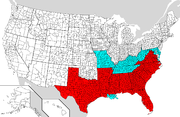
Maryland Constitution of 1864
The Maryland Constitution of 1864 was the third of the four constitutions which have governed the U.S. state of Maryland. A controversial product of the Civil War and in effect only until 1867, when the state's present constitution was adopted, the 1864 document was short-lived.-Drafting:The 1864...
on November 1 of that year. Article 24 of that document outlawed the practice of slavery. The right to vote was extended to non-white males in the Maryland Constitution of 1867, which remains in effect today.
The institution of slavery in Maryland had lasted just over 200 years, since the Assembly had first granted it formal legal status in 1663. In the end Maryland slaveholders received no compensation for their human property, the loss of which was estimated at around $30 million, a very large sum by the standards of the time.
See also
- History of MarylandHistory of MarylandThe history of Maryland included only Native Americans until Europeans, starting with John Cabot in 1498, began exploring the area. The first settlements came in 1634 when the English arrived in significant numbers and created a permanent colony. In 1776, during the American Revolution, Maryland...
- Maryland in the American Civil War
- Province of MarylandProvince of MarylandThe Province of Maryland was an English and later British colony in North America that existed from 1632 until 1776, when it joined the other twelve of the Thirteen Colonies in rebellion against Great Britain and became the U.S...
- Slavery in the colonial United States
- Slavery in the United States
External links
- University of Maryland Special Collections Guide on Slavery in Maryland
- Gurley, Ralph Randolph, Ed., p.251, The African Repository, Volume 3 Retrieved February 15, 2010.
- Proceedings of the Maryland Colonization Society at Niles' National Register, Volume 47 Retrieved February 16, 2010.
- Brief History of Maryland in Liberia at www.buckyogi.com Retrieved February 16, 2010.
- Brief History of Maryland in Liberia at www.worldstatesmen.org Retrieved February 16, 2010.

